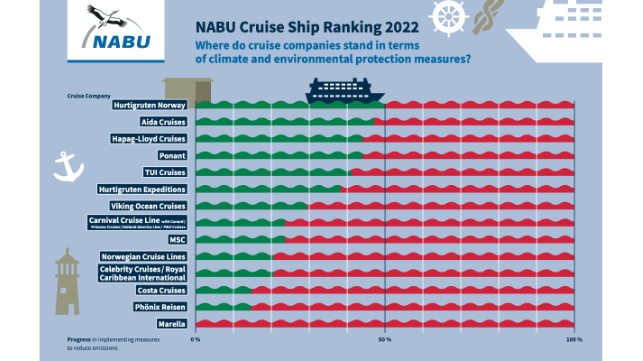NABU Cruise Ranking 2022: Companies Lagging Towards Climate Protection

The results of the tenth NABU cruise ranking show that cruise brands are still doing far too little to protect the environment, human health, and the climate. In the ranking, NABU evaluated the implemented measures and goals of cruise operators on the way to a clean climate-neutral cruise based on NABU's roadmap to 2040. Nineteen shipping companies were surveyed, and a total of 17 points could be scored. However, the first-placed Hurtigruten Norway, achieved just half of the achievable points, with all other companies rating behind. Among the top five are the three German companies AIDA, Hapag Lloyd cruises and TUI cruises, which can be considered pioneers especially for measures on large ships. The results also show, however, that the companies are mainly making promises and announcements, but so far little has been done in concrete terms to improve the situation.
Sönke Diesener, NABU cruise expert: "In the tenth year of the cruise ranking, the results once again show that environmental and climate protection are still not at the forefront for the cruise companies. Heavy fuel oil continues to be the fuel of choice for the majority of existing fleet. Only a few truly future-proof projects are in the planning and implementation stages. But the nature and climate crises are pressuring," Diesener adds; "By phasing out heavy fuel oil today and making zero emissions the standard for all newbuild ships cruise lines can credibly demonstrate that the announcements for a climate-neutral future for cruise shipping are actually serious."
The majority of cruise companies at least have a climate strategy by now and are committed to the Paris climate goals. The front runners start using modern technologies such as batteries and fuel cells. But for the time being only to complement the combustion engine. TUI Cruises ordered a ship that is planned to use methanol.
Nevertheless, heavy fuel dominates the market today, and order books almost exclusively feature fossil LNG ships. More and more ships are shore power capable, but actual usage is still very low. Hurtigruten, Hapag Lloyd Cruises and Ponant score well with heavy oil phase-out and shore power. On the other hand, smaller expedition vessels on a per passenger basis do not have a better environmental balance. Since there are often far fewer passengers on board the ships in the expedition segment. In addition, an expedition cruise is often accompanied by a flight to the other end of the world. Thus, the personal environmental footprint is finally ruined. Moreover, they are often traveling to particularly sensitive regions of the world.
Sönke Diesener, adds: "The winner Hurtigruten shows that cruises on fixed routes in coastal waters make the necessary climate and environmental measures more predictable and thus easier to implement. But it also shows that strict regulation helps. Norway has had a strict nitrogen oxide regime since 2007, and certain fjords may only be navigated by zero-emission ships soon. Thus, we need strict regulation across the board to force analogous development throughout the industry. This includes a general ban on heavy fuel oil, mandatory use of shore-side electricity, an e-fuels quota as well as stricter efficiency requirements and the large-scale designation of zero- and low-emission areas at sea."
The products and services herein described in this press release are not endorsed by The Maritime Executive.
